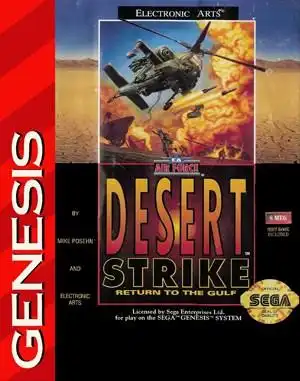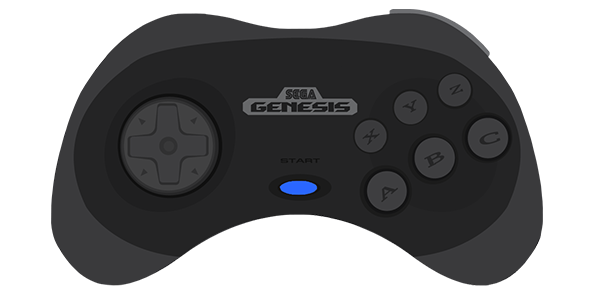Hovering over a pixelated warzone, managing fuel, ammo, and rescuing hostages – that was the thrilling reality for many gamers back in the early '90s. Electronic Arts delivered a true classic with Desert Strike: Return to the Gulf on Sega Genesis, a game that blended intense action with strategic thinking in a way few others did at the time. It wasn't just about shooting everything that moved; it was about careful planning, resource management, and executing missions under pressure.
Let's fire up the rotors and take a nostalgic flight back to see why this game remains a cherished memory for Genesis fans.
More Than Just a Shoot 'Em Up
While Desert Strike definitely involved a lot of shooting, calling it just a shoot 'em up feels incomplete. Viewed from a unique isometric perspective, you piloted a formidable AH-64 Apache helicopter. The game demanded more than quick reflexes. You had to:
- Manage Resources: Fuel was constantly draining, ammo was limited, and your armor could only take so many hits. Finding supply pickups or airlifting rescued personnel back to base was crucial for survival.
- Plan Your Route: Missions often involved multiple objectives spread across a large map. Deciding the most efficient order to tackle them, factoring in fuel and potential threats, was key.
- Tactical Engagement: Simply flying headfirst into a base was a recipe for disaster. Using terrain, flanking enemies, and prioritizing targets were essential tactics.
This blend of action and strategy set Desert Strike apart from its contemporaries.
Taking to the Skies: Gameplay and Missions
The core gameplay loop involved selecting a mission from the briefing screen, then flying your Apache into hostile territory. Your arsenal typically included a chain gun, Hydra rockets, and Hellfire missiles, each with different power and limited quantities.
Missions were varied and often multi-part:
- Destroying enemy installations (radar dishes, power plants, barracks).
- Eliminating specific high-value targets (tanks, choppers, commanders).
- Rescuing prisoners of war or hostages.
- Capturing enemy personnel for interrogation.
Air-lifting troops or prisoners involved carefully hovering over them and using your winch, a tense moment where you were vulnerable but gaining vital resources or completing objectives. The controls felt responsive, giving you precise command over the helicopter's movement and targeting.
The Gulf War Connection: Plot and Controversy
The game's setting and plot were clear parallels to the recent Gulf War. You were tasked with dismantling the forces of a ruthless dictator, General Kilbaba, who had invaded a wealthy emirate in the Persian Gulf.
While commercially successful, this real-world connection wasn't without controversy. Some critics and individuals felt the game was in poor taste, capitalizing on a recent conflict. However, for many players, it provided a compelling, albeit fictionalized, backdrop for the intense action. The plot unfolded through mission briefings and cinematic sequences, culminating in a final confrontation with Kilbaba himself.
Behind the Scenes: Development and Ports
Developed by Electronic Arts, Desert Strike was inspired by the classic Apple II game Choplifter. The lead designer, Mike Posehn, aimed for a non-linear experience with smooth animation. Interestingly, 3D modeling was used to create the vehicle sprites, which were then rendered and scaled for the 2D game, a technique that contributed to the game's impressive visual detail for the era.
While the Sega Genesis version is arguably the most iconic, Desert Strike was ported to numerous systems, including the SNES, Amiga, Atari Lynx, and various handhelds. Each version had its strengths and weaknesses, but the Genesis original captured the magic for a generation of gamers.
Legacy of the Apache
Desert Strike was a massive success for EA and spawned a series of sequels: Jungle Strike, Urban Strike, Soviet Strike, and Nuclear Strike. These built upon the core gameplay, introducing new vehicles and eventually transitioning to 3D graphics on later consoles.
The original Desert Strike: Return to the Gulf on Sega Genesis remains a standout title, remembered for its unique gameplay mix, challenging missions, and the feeling of being a lone Apache against overwhelming odds.
Playing Desert Strike Today
Feeling the urge to revisit the Gulf? The Sega Genesis version of Desert Strike is available through various means:
- Original Hardware: Dust off your old Genesis console and cartridge.
- Emulation: Emulators allow you to play the ROM on modern devices.
- Collections: The game has been included in several retro game compilations released on modern platforms.
However you choose to play, the tactical challenge and nostalgic charm hold up.
FAQ
Q: Is Desert Strike on Sega Genesis hard? A: Yes, Desert Strike is known for being quite challenging, primarily due to the need to manage limited resources like fuel and ammo while facing tough enemy resistance. Careful planning is essential.
Q: How many missions are in Desert Strike? A: The game typically features four main campaigns, each with multiple objectives that need to be completed before the final mission.
Q: What other games are like Desert Strike? A: The direct sequels (Jungle Strike, Urban Strike, etc.) are the most similar. The original inspiration, Choplifter, shares the rescue mechanic. Other isometric shooters might have some similarities, but Desert Strike's specific mix of action and strategy is fairly unique.
Q: Was Desert Strike controversial? A: Yes, due to its clear parallels to the real-world Gulf War, some people found the game's theme to be in poor taste at the time of its release.
Final Thoughts
Desert Strike: Return to the Gulf on Sega Genesis wasn't just another game; it was an experience. It taught us the value of planning, the tension of low fuel warnings, and the satisfaction of a perfectly executed mission. It's a prime example of the innovative and challenging gameplay that defined the 16-bit era. If you missed it the first time around, or if you're ready for another tour of duty, it's well worth experiencing this classic.


